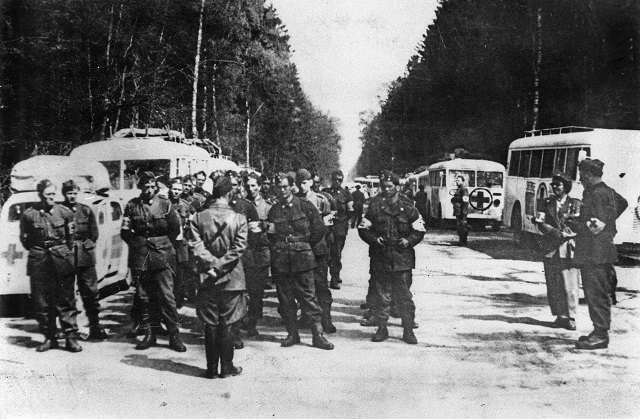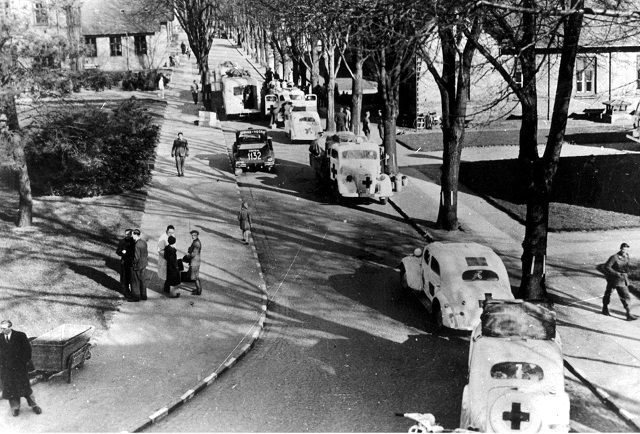The Swedish expedition that rescued thousands from Nazi concentration camps

In spring 1945, as the Second World War was nearing its end, Sweden carried out the biggest humanitarian relief expedition ever to take place within Nazi Germany.
This article is available to Members of The Local. Read more Membership Exclusives here.
Between March 8th and May 1st, 1945, during what became known as the White Buses expedition of the Swedish Red Cross, as many as 21,000 prisoners were liberated from active Nazi concentration camps and transported to Sweden for medical treatment and recuperation.
Excerpts from a collection of survivor testimonies preserved in the archives of Lund University help tell the story of this part of Swedish and European history.
"On 7 April 1945, the Swedish Red Cross mission began its work, and over the course of that day, so memorable to all the prisoners of the Ravensbrück camp (it was a Saturday), survivors returned from Uckermark [an extermination camp]. Then, in the evening, the first Swedish Red Cross vehicles drove into the camp. They brought food parcels and took the first transport of women (Norwegians and Danes) to their freedom," recalled Zofia Mączka, a physician from Poland who been imprisoned in the Ravensbrück concentration camp for women in northern Germany since September 1941.
When Count Folke Bernadotte, a member of the Swedish royal family who served as vice president of the Swedish Red Cross, struck the initial agreement with SS Commander Heinrich Himmler, who was operating behind Adolf Hitler’s back, it was intended only to secure the release of Danish and Norwegian prisoners in selected concentration camps. From April 21st, however, the agreement was extended to prisoners of all nationalities, beginning with the women in Ravensbrück.

Photo: PrB/TT
"On 25 April 1945, suddenly all the Polish women were summoned to assemble on the roll call square with their dressed infants. We got scared because we assumed that we were to go to our deaths," recalled Stefania Wodzyńska, a 22-year-old Polish Catholic prisoner who had given birth while imprisoned in Ravensbrück.
"Unexpectedly, behind the wire fence, white buses with Red Cross showed up. The majority of us did not trust in liberation as Germans played often with traps and deviousness under the mantle of the Red Cross," explained Estera Melchior, a 19-year-old Polish Jewish prisoner of Malchow, a sub-camp of Ravensbrück, recalling her experiences of the same day.
"The buses, which [turned out] to be part of Count Folke Bernadotte’s rescue action, carried us [to] liberation and the freedom we only dreamt of," recalled Estera, who had survived the Warsaw ghetto and three concentration camps, including Malchow.
First, however, the buses had to safely make their way into and out of working concentration camps staffed by hostile Nazi guards and the Gestapo, and through two active front lines. Throughout the journey, despite the large red crosses and Swedish flags painted on the roof and sides of the vehicles, the White Bus convoys were vulnerable to the fierce Allied aerial attacks being conducted in Germany.
Recommended reading:
"The bus stopped for the night in a forest under the trees, because the Germans were being heavily bombed by Americans at that time, and one of the vehicles in the previous transport had been bombed," recalled Natalia Chodkiewicz, a 56-year-old Polish Catholic who had been a political prisoner in Ravensbrück. "While we were stopped in the forest, we could feel the ground shake from the detonations."
The incident Natalia referred to was one of two convoys carrying a total of 706 female prisoners from Ravensbrück which were bombed by Allied fighter jets on April 25th, claiming the lives of 25 people.
One of the convoys was bombed twice. The first incident killed the Swedish driver and several rescued prisoners and injured 16 others. Back on the road, the second bombing killed a further ten former prisoners and injured 20 more.
Risking their lives in this effort were 308 members of the Swedish military who took a leave of absence to serve in an official capacity as Red Cross volunteers. They carried out the well-planned and organized operation using 36 buses and other vehicles provided by the Swedish military. Later, the Danish government provided significant additional manpower and vehicles to the expedition.

The buses make their way to safety. Photo: Scanpix/TT
By May 1st, the last of the White Buses had returned to Sweden. The war in Europe ended just a week later on May 8th.
Though the total number of liberated prisoners varies depending on the source, several scholars have independently determined that between 7,000 and 8,000 were Danish and Norwegian, while 12,000 were of other nationalities, including around 6,000 Poles.
Survivors like Zofia, Stefania, Estera and Natalia were just a few who described what it was like arriving in Sweden after, in the words of another survivor, "leaving the hell behind us."
Having safely made the remainder of the journey after the harrowing night in the forest, Natalia recalled, "On 28 April 1945, we disembarked at Malmö, freed from the threat of torture and death thanks to the initiative of the Swedish government and Count Bernadotte, and since then the lovely country of Sweden has been offering us hospitality."
Victoria Martínez is an American historical researcher, writer and author of three historical non-fiction books. She lives in Småland county, Sweden, with her Spanish husband and their two children.
Comments
See Also
Between March 8th and May 1st, 1945, during what became known as the White Buses expedition of the Swedish Red Cross, as many as 21,000 prisoners were liberated from active Nazi concentration camps and transported to Sweden for medical treatment and recuperation.
Excerpts from a collection of survivor testimonies preserved in the archives of Lund University help tell the story of this part of Swedish and European history.
"On 7 April 1945, the Swedish Red Cross mission began its work, and over the course of that day, so memorable to all the prisoners of the Ravensbrück camp (it was a Saturday), survivors returned from Uckermark [an extermination camp]. Then, in the evening, the first Swedish Red Cross vehicles drove into the camp. They brought food parcels and took the first transport of women (Norwegians and Danes) to their freedom," recalled Zofia Mączka, a physician from Poland who been imprisoned in the Ravensbrück concentration camp for women in northern Germany since September 1941.
When Count Folke Bernadotte, a member of the Swedish royal family who served as vice president of the Swedish Red Cross, struck the initial agreement with SS Commander Heinrich Himmler, who was operating behind Adolf Hitler’s back, it was intended only to secure the release of Danish and Norwegian prisoners in selected concentration camps. From April 21st, however, the agreement was extended to prisoners of all nationalities, beginning with the women in Ravensbrück.

Photo: PrB/TT
"On 25 April 1945, suddenly all the Polish women were summoned to assemble on the roll call square with their dressed infants. We got scared because we assumed that we were to go to our deaths," recalled Stefania Wodzyńska, a 22-year-old Polish Catholic prisoner who had given birth while imprisoned in Ravensbrück.
"Unexpectedly, behind the wire fence, white buses with Red Cross showed up. The majority of us did not trust in liberation as Germans played often with traps and deviousness under the mantle of the Red Cross," explained Estera Melchior, a 19-year-old Polish Jewish prisoner of Malchow, a sub-camp of Ravensbrück, recalling her experiences of the same day.
"The buses, which [turned out] to be part of Count Folke Bernadotte’s rescue action, carried us [to] liberation and the freedom we only dreamt of," recalled Estera, who had survived the Warsaw ghetto and three concentration camps, including Malchow.
First, however, the buses had to safely make their way into and out of working concentration camps staffed by hostile Nazi guards and the Gestapo, and through two active front lines. Throughout the journey, despite the large red crosses and Swedish flags painted on the roof and sides of the vehicles, the White Bus convoys were vulnerable to the fierce Allied aerial attacks being conducted in Germany.
"The bus stopped for the night in a forest under the trees, because the Germans were being heavily bombed by Americans at that time, and one of the vehicles in the previous transport had been bombed," recalled Natalia Chodkiewicz, a 56-year-old Polish Catholic who had been a political prisoner in Ravensbrück. "While we were stopped in the forest, we could feel the ground shake from the detonations."
The incident Natalia referred to was one of two convoys carrying a total of 706 female prisoners from Ravensbrück which were bombed by Allied fighter jets on April 25th, claiming the lives of 25 people.
One of the convoys was bombed twice. The first incident killed the Swedish driver and several rescued prisoners and injured 16 others. Back on the road, the second bombing killed a further ten former prisoners and injured 20 more.
Risking their lives in this effort were 308 members of the Swedish military who took a leave of absence to serve in an official capacity as Red Cross volunteers. They carried out the well-planned and organized operation using 36 buses and other vehicles provided by the Swedish military. Later, the Danish government provided significant additional manpower and vehicles to the expedition.

The buses make their way to safety. Photo: Scanpix/TT
By May 1st, the last of the White Buses had returned to Sweden. The war in Europe ended just a week later on May 8th.
Though the total number of liberated prisoners varies depending on the source, several scholars have independently determined that between 7,000 and 8,000 were Danish and Norwegian, while 12,000 were of other nationalities, including around 6,000 Poles.
Survivors like Zofia, Stefania, Estera and Natalia were just a few who described what it was like arriving in Sweden after, in the words of another survivor, "leaving the hell behind us."
Having safely made the remainder of the journey after the harrowing night in the forest, Natalia recalled, "On 28 April 1945, we disembarked at Malmö, freed from the threat of torture and death thanks to the initiative of the Swedish government and Count Bernadotte, and since then the lovely country of Sweden has been offering us hospitality."
Victoria Martínez is an American historical researcher, writer and author of three historical non-fiction books. She lives in Småland county, Sweden, with her Spanish husband and their two children.
Join the conversation in our comments section below. Share your own views and experience and if you have a question or suggestion for our journalists then email us at [email protected].
Please keep comments civil, constructive and on topic – and make sure to read our terms of use before getting involved.
Please log in here to leave a comment.